Optical Frequency Comb Expansion Using Mutually Injection-Locked Gain-Switched Lasers
Abstract
:1. Introduction
2. Mutually Injection-Locked Gain-Switched Laser
2.1. Operational Principle
2.2. Experimental Setup
3. Results and Discussion
3.1. Expanded OFC Generation Using MIL-GS Lasers
3.1.1. Comb Expansion
3.1.2. Comb Densification
3.2. Comb Line Characterization
3.2.1. Phase Noise and Relative Intensity Noise
3.2.2. Phase Correlation
4. Conclusions
Author Contributions
Funding
Institutional Review Board Statement
Informed Consent Statement
Conflicts of Interest
References
- Hänsch, T.W. Nobel Lecture: Passion for precision. Rev. Mod. Phys. 2006, 78, 1297–1309. [Google Scholar] [CrossRef] [Green Version]
- Hall, J. Nobel Lecture: Defining and measuring optical frequencies. Rev. Mod. Phys. 2006, 78, 1279–1295. [Google Scholar] [CrossRef] [Green Version]
- Holzwarth, R.; Udem, T.; Hänsch, T.W.; Knight, J.; Wadsworth, W.; Russell, P. Optical Frequency Synthesizer for Precision Spectroscopy. Phys. Rev. Lett. 2000, 85, 2264–2267. [Google Scholar] [CrossRef] [PubMed] [Green Version]
- Minoshima, K.; Matsumoto, H. High-accuracy measurement of 240-m distance in an optical tunnel by use of a compact femtosecond laser. Appl. Opt. 2000, 39, 5512–5517. [Google Scholar] [CrossRef]
- Hu, H.; Da Ros, F.; Pu, M.; Ye, F.; Ingerslev, K.; Da Silva, E.P.; Nooruzzaman, M.; Amma, Y.; Sasaki, Y.; Mizuno, T. Single-source chip-based frequency comb enabling extreme parallel data transmission. Nat. Photon. 2018, 12, 469–473. [Google Scholar] [CrossRef]
- Zhou, R.; Huynh, T.N.; Vujicic, V.; Anandarajah, P.M.; Barry, L.P. Phase noise analysis of injected gain switched comb source for coherent communications. Opt. Express 2014, 22, 8120–8125. [Google Scholar] [CrossRef]
- Imran, M.; Anandarajah, P.M.; Kaszubowska-Anandarajah, A.; Sambo, N.; Poti, L. A Survey of Optical Carrier Generation Techniques for Terabit Capacity Elastic Optical Networks. IEEE Commun. Surv. Tutor. 2017, 20, 211–263. [Google Scholar] [CrossRef] [Green Version]
- Vujicic, V.; Anandarajah, P.M.; Zhou, R.; Browning, C.; Barry, L.P. Performance Investigation of IM/DD Compatible SSB-OFDM Systems Based on Optical Multicarrier Source. IEEE Photon. J. 2014, 6, 1–10. [Google Scholar] [CrossRef]
- Pfeifle, J.; Vujicic, V.; Watts, R.; Schindler, P.C.; Weimann, C.; Zhou, R.; Freude, W.; Barry, L.; Koos, C. Flexible terabit/s Nyquist-WDM super-channels using a gain-switched comb source. Opt. Express 2015, 23, 724–738. [Google Scholar] [CrossRef] [Green Version]
- Anandarajah, P.M.; Zhou, R.; Maher, R.; Pascual, D.M.G.; Smyth, F.; Vujicic, V.; Barry, L.P. Flexible Optical Comb Source for Super Channel Systems. In Proceedings of the Optical Fiber Communication Conference 2013, Anaheim, CA, USA, 17–21 March 2013. [Google Scholar]
- Supradeepa, V.R.; Long, C.M.; Wu, R.; Ferdous, F.; Hamidi, E.; Leaird, D.E.; Weiner, A.M. Comb-based radiofrequency photonic filters with rapid tunability and high selectivity. Nat. Photon. 2012, 6, 186–194. [Google Scholar] [CrossRef] [Green Version]
- Fortier, T.; Baumann, E. 20 years of developments in optical frequency comb technology and applications. Commun. Phys. 2019, 2, 1–16. [Google Scholar] [CrossRef]
- Bosco, G.; Curri, V.; Carena, A.; Poggiolini, P.; Forghieri, F. On the Performance of Nyquist-WDM Terabit Superchannels Based on PM-BPSK, PM-QPSK, PM-8QAM or PM-16QAM Subcarriers. J. Light. Technol. 2010, 29, 53–61. [Google Scholar] [CrossRef]
- Shao, T.; Shams, H.; Anandarajah, P.; Fice, M.J.; Renaud, C.; Van Dijk, F.; Seeds, A.; Barry, L. Phase Noise Investigation of Multicarrier Sub-THz Wireless Transmission System Based on an Injection-Locked Gain-Switched Laser. IEEE Trans. Terahertz Sci. Technol. 2015, 5, 590–597. [Google Scholar] [CrossRef] [Green Version]
- Alexander, J.K.; Caro, L.; Dernaika, M.; Duggan, S.P.; Yang, H.; Chandran, S.; Martin, E.P.; Ruth, A.A.; Anandarajah, P.M.; Peters, F.H.; et al. Integrated dual optical frequency comb source. Opt. Express 2020, 28, 16900–16906. [Google Scholar] [CrossRef] [PubMed]
- Martin, E.P.; Chandran, S.; Rosado, A.; Soderholm, E.P.; Alexander, J.K.; Peters, F.H.; Ruth, A.A.; Anandarajah, P.M. Mutually Injection Locked Gain Switched Optical Frequency Combs for Dual Comb Spectroscopy of H2S. In Proceedings of the CLEO: Applications and Technology 2020, Washington, DC, USA, 10–15 May 2020. [Google Scholar]
- Habruseva, T.; O’Donoghue, S.; Rebrova, N.; Kéfélian, F.; Hegarty, S.P.; Huyet, G. Optical linewidth of a passively mode-locked semiconductor laser. Opt. Lett. 2009, 34, 3307–3309. [Google Scholar] [CrossRef] [Green Version]
- Del’Haye, P.; Arcizet, O.; Schliesser, A.; Holzwarth, R.; Kippenberg, T.J. Full Stabilization of a Microresonator-Based Optical Frequency Comb. Phys. Rev. Lett. 2008, 101, 053903. [Google Scholar] [CrossRef] [PubMed] [Green Version]
- Fujiwara, M.; Kani, J.; Suzuki, H.; Araya, K.; Teshima, M. Flattened optical multicarrier generation of 12.5 GHz spaced 256 channels based on sinusoidal amplitude and phase hybrid modulation. Electron. Lett. 2001, 37, 967–968. [Google Scholar] [CrossRef]
- Anandarajah, P.; Maher, R.; Xu, Y.Q.; Latkowski, S.; O’Carroll, J.; Murdoch, S.G.; Phelan, R.; O’Gorman, J.; Barry, L. Generation of Coherent Multicarrier Signals by Gain Switching of Discrete Mode Lasers. IEEE Photon. J. 2011, 3, 112–122. [Google Scholar] [CrossRef]
- Zhou, R.; Latkowski, S.; O’Carroll, J.; Phelan, R.; Barry, L.; Anandarajah, P. 40 nm wavelength tunable gain-switched optical comb source. Opt. Express 2011, 19, B415–B420. [Google Scholar] [CrossRef]
- Shao, T.; Zhou, R.; Pascual, M.D.G.; Anandarajah, P.M.; Barry, L.P.; Pascual, D.; Prince, A. Integrated Gain Switched Comb Source for 100 Gb/s WDM-SSB-DD-OFDM System. J. Light. Technol. 2015, 33, 3525–3532. [Google Scholar] [CrossRef]
- Venkatasubramani, L.N.; Lin, Y.; Browning, C.; Vijay, A.; Smyth, F.; Koilpillai, D.; Venkitesh, D.; Barry, L. CO-OFDM for Bandwidth-Reconfigurable Optical Interconnects using Gain Switched Comb. OSA Contin. 2020, 3, 2925–2934. [Google Scholar] [CrossRef]
- Ahmad, S.T.; Lakshmijayasimha, P.D.; Anandarajah, P.M.; Kaszubowska-Anandarajah, A. 200 Gb/s Short Reach Transmitters Based on Optical Frequency Combs. In Proceedings of the 2020 22nd International Conference on Transparent Optical Networks (ICTON), Bari, Italy, 19–23 July 2020; pp. 1–2. [Google Scholar]
- Pascual, M.D.G.; Vujicic, V.; Braddell, J.; Smyth, F.; Anandarajah, P.; Barry, L. Photonic Integrated Gain Switched Optical Frequency Comb for Spectrally Efficient Optical Transmission Systems. IEEE Photon. J. 2017, 9, 1–8. [Google Scholar] [CrossRef]
- Quevedo-Galán, C.; Durán, V.; Rosado, A.; Perez-Serrano, A.; Tijero, J.M.G.; Esquivias, I. Gain-switched semiconductor lasers with pulsed excitation and optical injection for dual-comb spectroscopy. Opt. Express 2020, 28, 33307–33317. [Google Scholar] [CrossRef] [PubMed]
- Weng, W.; Kaszubowska-Anandarajah, A.; He, J.; Lakshmijayasimha, P.D.; Lucas, E.; Liu, J.; Anandarajah, P.M.; Kippenberg, T.J. Gain-switched semiconductor laser driven soliton microcombs. Nat. Commun. 2021, 12, 1–9. [Google Scholar] [CrossRef]
- Hei, K.; Kaszubowska-Anandarajah, A.; Martin, E.P.; Shi, G.; Anandarajah, P.M.; Bhattacharya, N. Absolute distance measurement with a gain-switched dual optical frequency comb. Opt. Express 2021, 29, 8108–8116. [Google Scholar] [CrossRef]
- Zhou, R.; Anandarajah, P.; Pascual, M.D.G.; O’Carroll, J.; Phelan, R.; Kelly, B.; Barry, L. Monolithically Integrated 2-Section Lasers for Injection Locked Gain Switched Comb Generation. In Proceedings of the Optical Fiber Communication Conference 2014, San Francisco, CA, USA, 9–13 March 2014. [Google Scholar]
- Pascual, M.D.G.; Vujicic, V.; Braddell, J.; Smyth, F.; Anandarajah, P.M.; Barry, L.P. InP photonic integrated externally injected gain switched optical frequency comb. Opt. Lett. 2017, 42, 555–558. [Google Scholar] [CrossRef]
- Hammad, M.N.; Lakshmijayasimha, P.D.; Kaszubowska-Anandarajah, A.; Anandarajah, P.M. Photonically integrated gain-switched lasers for optical frequency comb generation. Microw. Opt. Technol. Lett. 2021, 63, 2219–2226. [Google Scholar] [CrossRef]
- Rosado, A.; Pérez-Serrano, A.; Tijero, J.M.G.; Valle, Á.; Pesquera, L.; Esquivias, I. Enhanced optical frequency comb generation by pulsed gain-switching of optically injected semiconductor lasers. Opt. Express 2019, 27, 9155–9163. [Google Scholar] [CrossRef] [PubMed]
- Prior, E.; de Dios, C.; Criado, R.; Ortsiefer, M.; Meissner, P.; Acedo, P. Expansion of VCSEL-Based Optical Frequency Combs in the Sub-THz Span: Comparison of Non-Linear Techniques. J. Light. Technol. 2016, 34, 4135–4142. [Google Scholar] [CrossRef] [Green Version]
- Lakshmijayasimha, P.D.; Kaszubowska-Anandarajah, A.; Martin, E.P.; Landais, P.; Anandarajah, P.M. Expansion and phase correlation of a wavelength tunable gain-switched optical frequency comb. Opt. Express 2019, 27, 16560–16570. [Google Scholar] [CrossRef]
- Pascual, M.D.G.; Anandarajah, P.; Zhou, R.; Smyth, F.; Latkowski, S.; Barry, L. Cascaded Fabry-Pérot lasers for coherent expansion of wavelength tunable gain switched comb. In Proceedings of the 40th European Conference on Optical Communications (ECOC 2014), Cannes, France, 21–25 September 2014; pp. 1–3. [Google Scholar]
- Pascual, M.D.G.; Zhou, R.; Smyth, F.; Shao, T.; Anandarajah, P.M.; Barry, L. Dual mode injection locking of a Fabry-Pérot laser for tunable broadband gain switched comb generation. In Proceedings of the European Conference on Optical Communication (ECOC), Valencia, Spain, 27 September–1 October 2015; pp. 1–3. [Google Scholar]
- Delmade, A.; Krstić, M.; Browning, C.; Crnjanski, J.; Gvozdić, D.; Barry, L. Power efficient optical frequency comb generation using laser gain switching and dual-drive Mach-Zehnder modulator. Opt. Express 2019, 27, 24135–24146. [Google Scholar] [CrossRef]
- Yang, W.-Y.; Xia, G.-Q.; Jiang, Z.-F.; Deng, T.; Lin, X.-D.; Jin, Y.-H.; Xiao, Z.-Z.; Yue, D.-Z.; Hu, C.-X.; Cui, B.; et al. Experimental Investigation on Wideband Optical Frequency Comb Generation Based on a Gain-Switched 1550 nm Multi-Transverse Mode Vertical-Cavity Surface-Emitting Laser Subject to Dual Optical Injection. IEEE Access 2020, 8, 170203–170210. [Google Scholar] [CrossRef]
- Herbert, C.; Anandarajah, P.; Perry, P.; Jones, D.; Kaszubowska-Anandarajah, A.; Barry, L.; Kelly, B.; O’Carroll, J.; O’Gorman, J.; Rensing, M.; et al. Discrete mode lasers for communication applications. IET Optoelectron. 2009, 3, 1–17. [Google Scholar] [CrossRef]
- O’Duill, S.P.; Zhou, R.; Anandarajah, P.; Barry, L. Analytical Approach to Assess the Impact of Pulse-to-Pulse Phase Coherence of Optical Frequency Combs. IEEE J. Quantum Electron. 2015, 51, 1–8. [Google Scholar] [CrossRef]
- Huynh, T.N.; Nguyen, L.; Barry, L. Phase Noise Characterization of SGDBR Lasers Using Phase Modulation Detection Method with Delayed Self-Heterodyne Measurements. J. Light. Technol. 2013, 31, 1300–1308. [Google Scholar] [CrossRef]
- Lakshmijayasimha, P.D.; Kaszubowska-Anandarajah, A.; Martin, E.P.; Hammad, M.N.; Landais, P.; Anandarajah, P.M. Characterization of a multifunctional active demultiplexer for optical frequency combs. Opt. Laser Technol. 2021, 134, 106637. [Google Scholar] [CrossRef]
- Relative Intensity Noise of Distributed Feedback Lasers, Application Note. Available online: https://www.eagleyard.com/fileadmin/downloads/documents/eyP_App_Note_RIN__1-6.pdf (accessed on 13 May 2020).
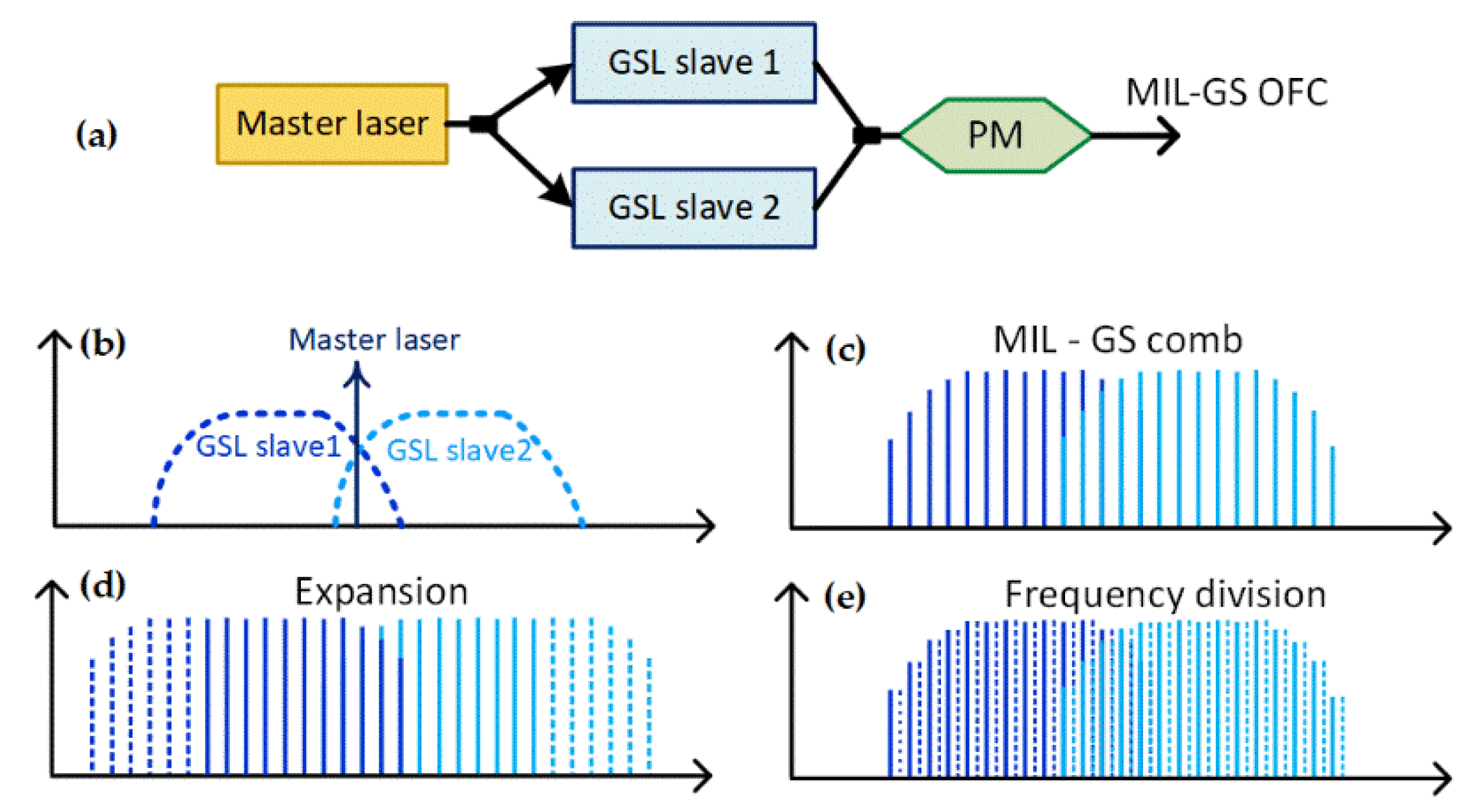
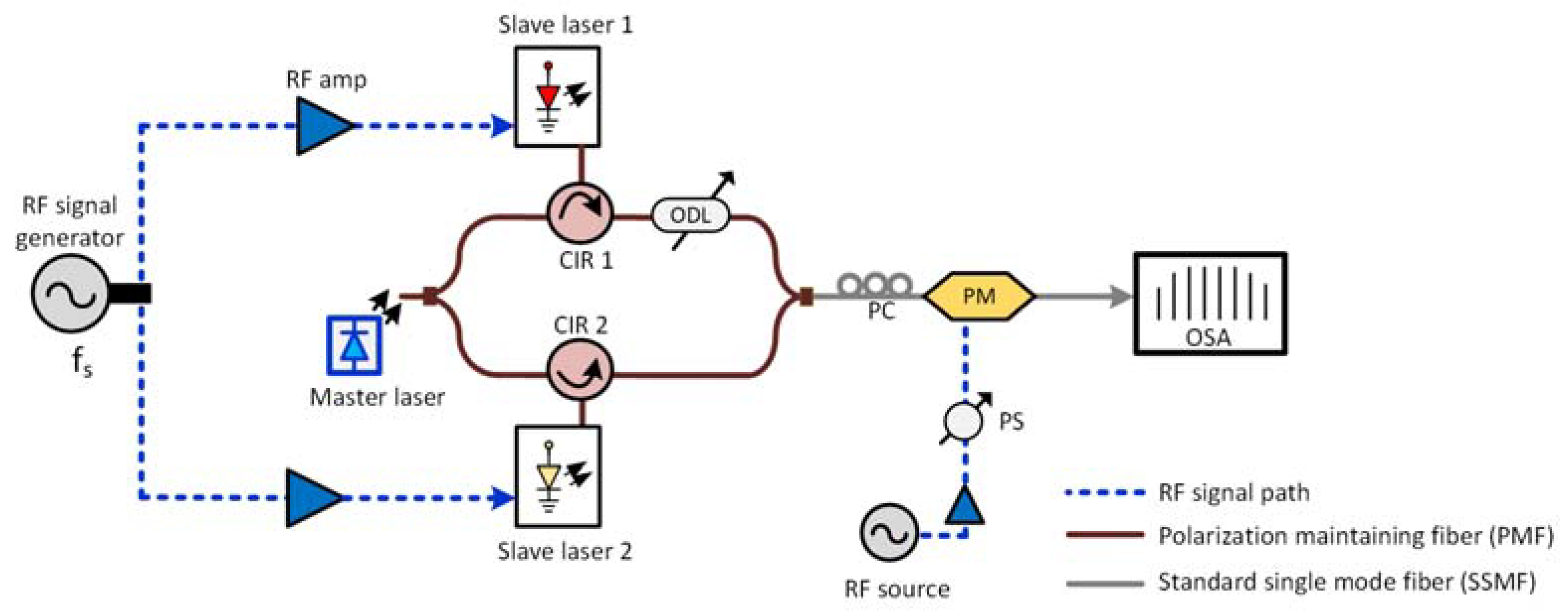
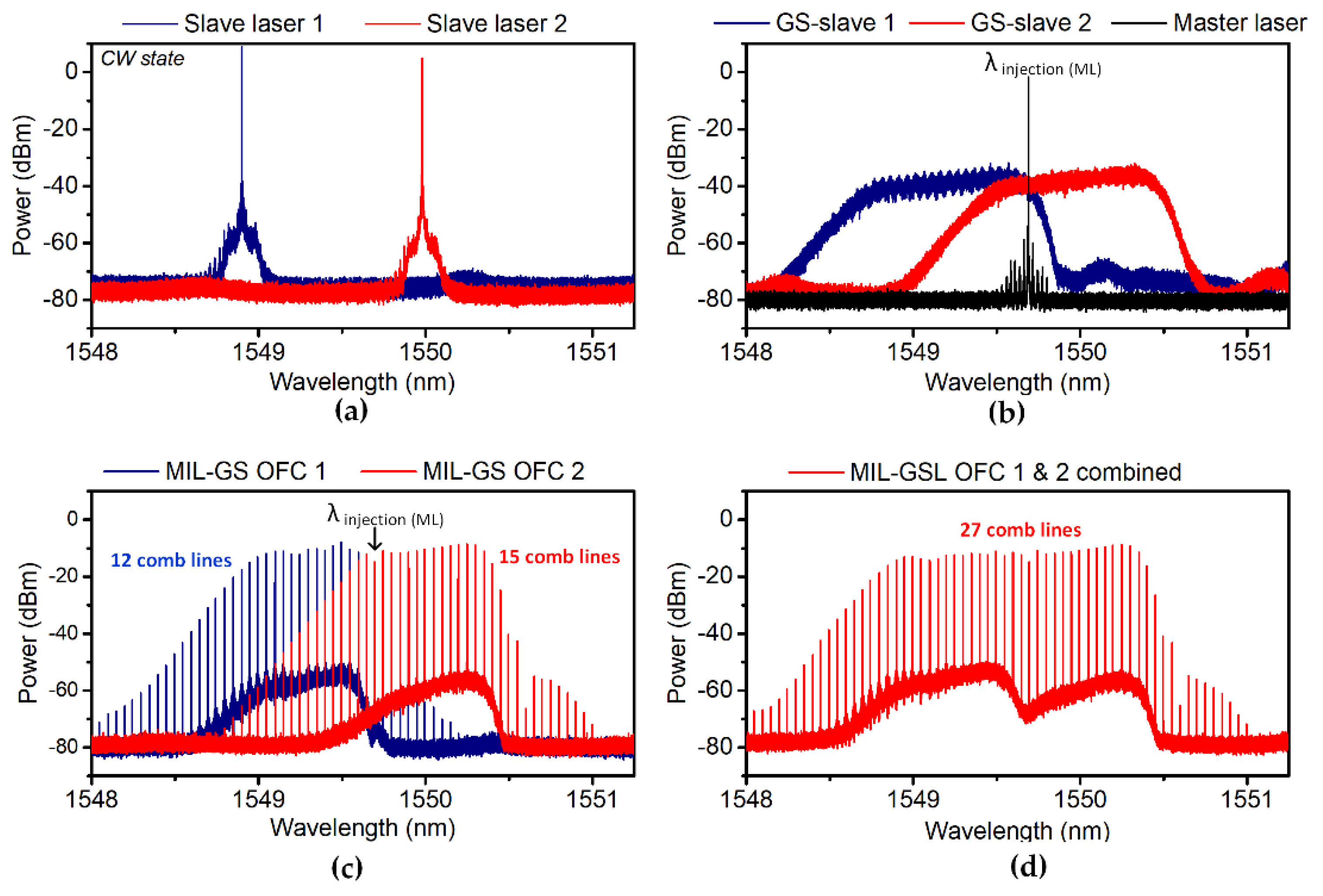
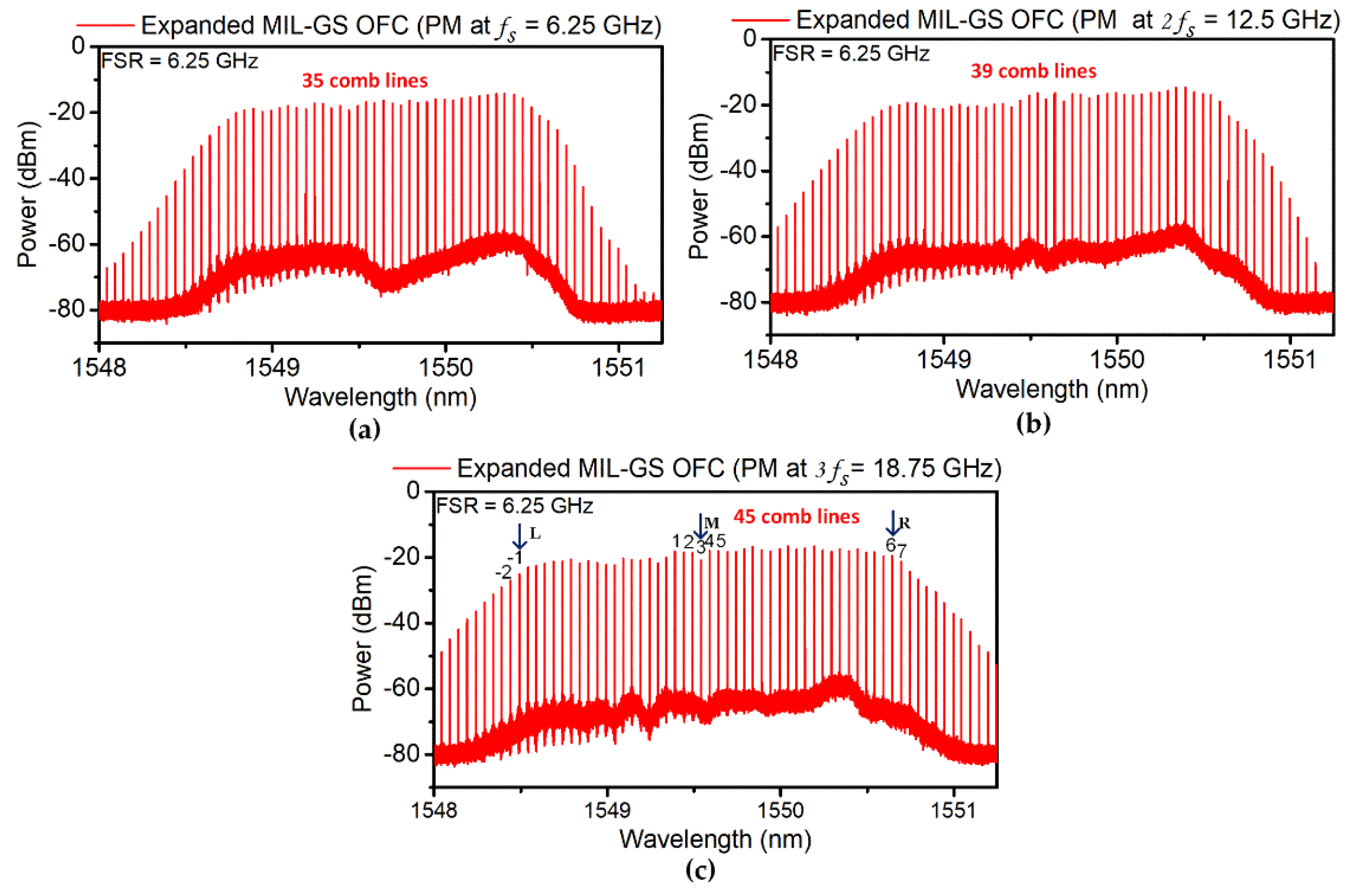
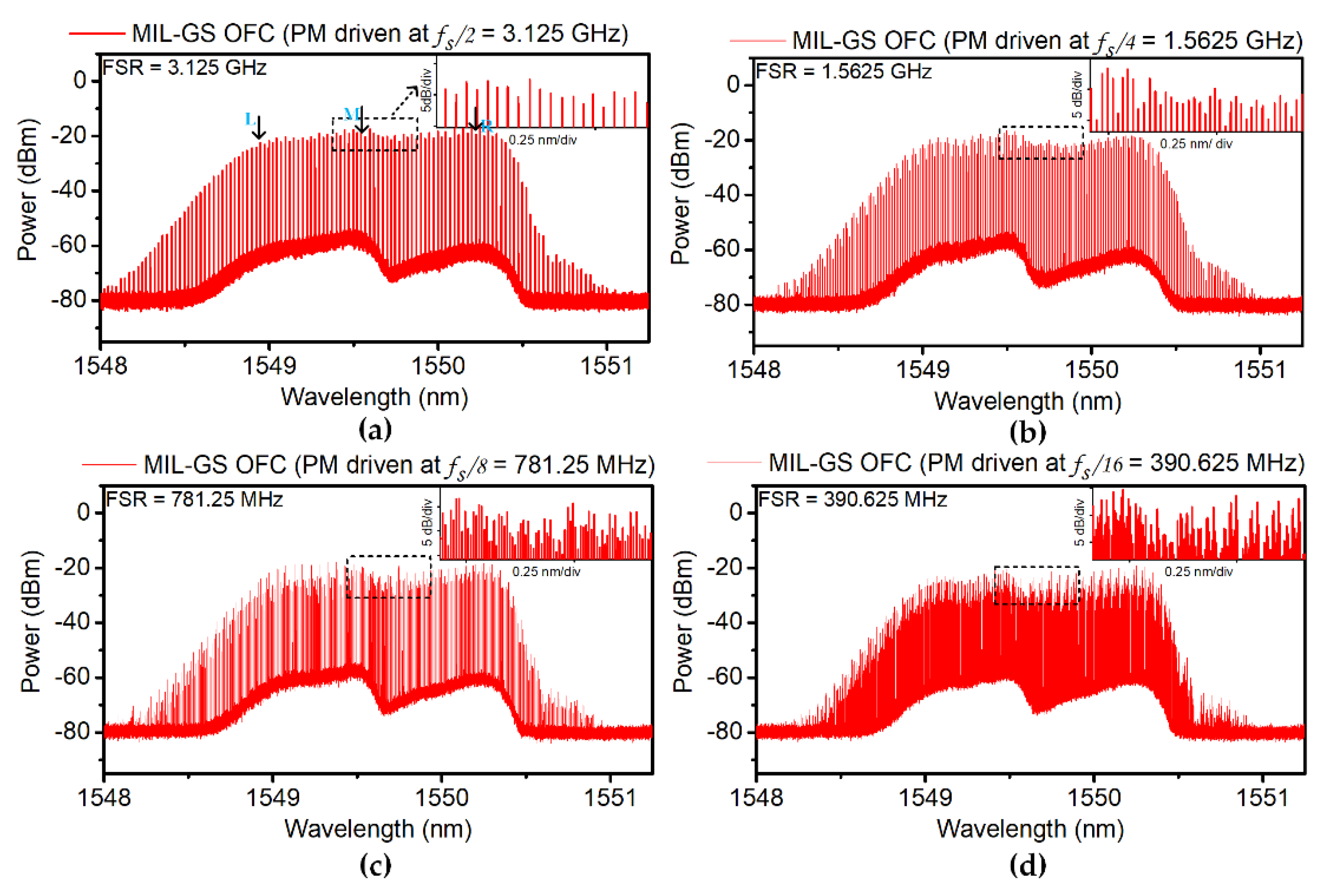
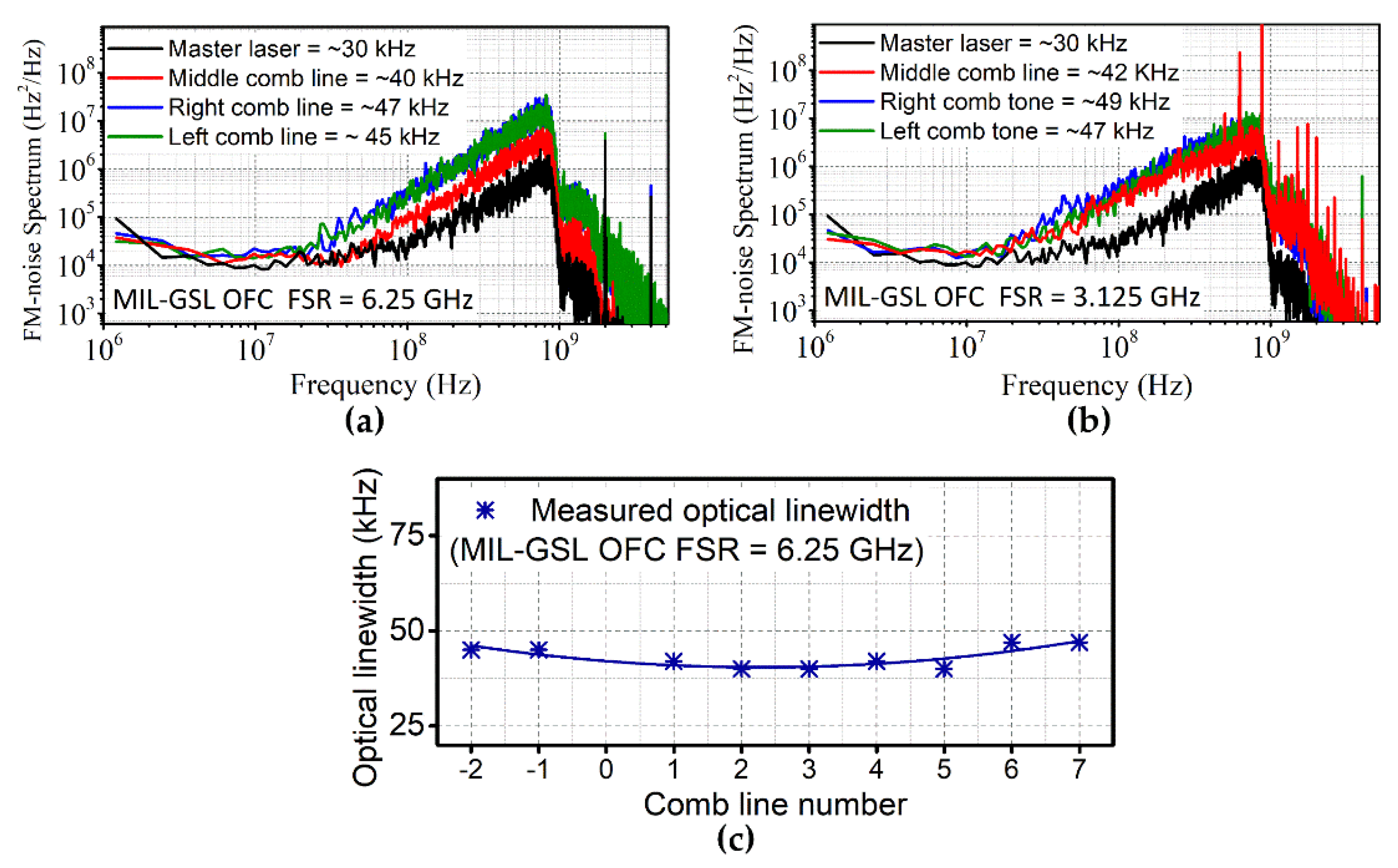

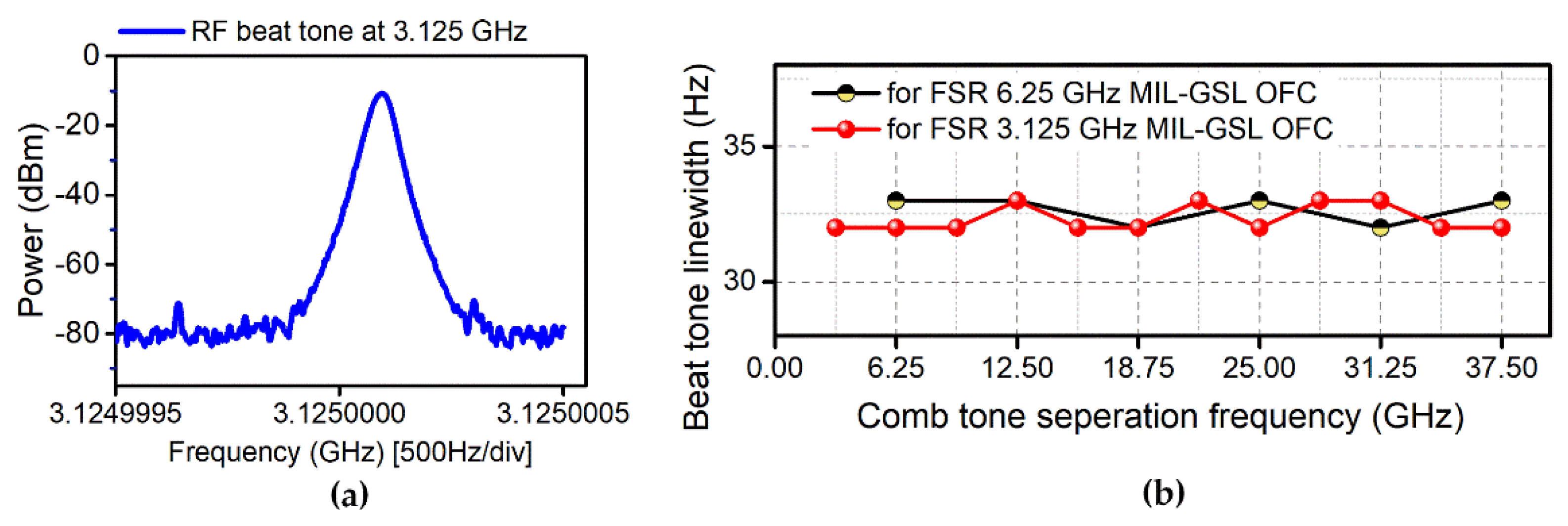
| Ref. | Key Expansion Component | OFC FSR | Expansion Factor | Photonic Integration | Demonstration/Comments |
|---|---|---|---|---|---|
| [21] | FP + phase modulator | 10 GHz | ~ 2 | Yes | 40 nm wavelength tunability; limited expansion |
| [20] | HNLF + DCF | 10.7 GHz | >3 | No | Wide comb generation; complexity and stability issues |
| [35] | Cascaded GS FP lasers | 10 GHz | ~2 | Yes | 20 nm wavelength tunability; limited expansion; low OCNR |
| [36] | Dual-mode FP IL | 6.25 GHz | >2 | Yes | Simple; 30 nm wavelength tunability; poor flatness; low OCNR |
| [38] | VCSEL HNLF + DCF + Modulator | 5.2 GHz | ~3 | No | Wide comb generation; complexity; stability issues; low OCNR |
| [34] | Parallel cascaded FP + SOA | 6.25 GHz | >3 | Yes | Wide comb generation; amplified output power; 30 nm wavelength tunability; complex |
| [37] | Dual-drive MZM | 9.5 GHz | >1.5 | Partially | Simple; low drive voltage; limited expansion |
| [38] | VCSEL + dual mode injection locking | 2.5 GHz | ~2 | Yes | Simple; limited expansion |
| This work | Mutual injection locking + phase modulator | 6.25 GHz | ~3 | Yes | Wide comb generation; simple; FSR tunability from 390 MHz to 6.25 GHz |
| OFC Type | Number of Lines (5 dB from Peak) | Comb Bandwidth | Expansion Factor |
|---|---|---|---|
| Individual GSL OFC | 15 | ~93.7 GHz | -- |
| Combined MIL-GSL OFC | 27 | ~168.75 GHz | 1.8 |
| MIL OFC + PM (at 6.25 GHz) | 35 | ~218.75 GHz | 2.3 |
| MIL OFC + PM (at 12.5 GHz) | 39 | ~243.75 GHz | 2.6 |
| MIL OFC + PM (at 18.75 GHz) | 45 | ~281.25 GHz | 3 |
| MIL-GSL OFC FSR | OCNR (Tone at ~1550 nm) | Number of Lines (5 dB from Peak) |
|---|---|---|
| 6.25 GHz | 50 | 27 |
| 3.125 GHz | 45 | 58 |
| 1.5625 GHz | ~42 | ~113 |
| 781.25 MHz | ~38 | ~214 (within 10 dB) |
| 390.625 MHz | ~33 | ~453 (within 10 dB) |
| Phase Noise | RIN | |||
|---|---|---|---|---|
| 6.25 GHz | 3.125 GHz | 6.25 GHZ | 3.125 GHz | |
| Master laser | ~30 kHz | ~30 kHz | ~−157.2 dB/Hz | ~−157.2 dB/Hz |
| Comb line (middle) | ~40 kHz | ~42 kHz | ~−152.1 dB/Hz | ~−152.8 dB/Hz |
| Comb line (right) | ~47 kHz | ~49 kHz | ~−152.7 dB/Hz | ~−152.5 dB/Hz |
| Comb line (left) | ~45 kHz | ~47 kHz | ~−152.6 dB/Hz | ~−152.5 dB/Hz |
Publisher’s Note: MDPI stays neutral with regard to jurisdictional claims in published maps and institutional affiliations. |
© 2021 by the authors. Licensee MDPI, Basel, Switzerland. This article is an open access article distributed under the terms and conditions of the Creative Commons Attribution (CC BY) license (https://creativecommons.org/licenses/by/4.0/).
Share and Cite
Lakshmijayasimha, P.D.; Anandarajah, P.M.; Landais, P.; Kaszubowska-Anandarajah, A. Optical Frequency Comb Expansion Using Mutually Injection-Locked Gain-Switched Lasers. Appl. Sci. 2021, 11, 7108. https://doi.org/10.3390/app11157108
Lakshmijayasimha PD, Anandarajah PM, Landais P, Kaszubowska-Anandarajah A. Optical Frequency Comb Expansion Using Mutually Injection-Locked Gain-Switched Lasers. Applied Sciences. 2021; 11(15):7108. https://doi.org/10.3390/app11157108
Chicago/Turabian StyleLakshmijayasimha, Prajwal D., Prince M. Anandarajah, Pascal Landais, and Aleksandra Kaszubowska-Anandarajah. 2021. "Optical Frequency Comb Expansion Using Mutually Injection-Locked Gain-Switched Lasers" Applied Sciences 11, no. 15: 7108. https://doi.org/10.3390/app11157108
APA StyleLakshmijayasimha, P. D., Anandarajah, P. M., Landais, P., & Kaszubowska-Anandarajah, A. (2021). Optical Frequency Comb Expansion Using Mutually Injection-Locked Gain-Switched Lasers. Applied Sciences, 11(15), 7108. https://doi.org/10.3390/app11157108







